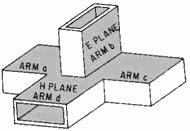Monopulse Principles and Techniques |
|
Click here for the complete list of RF Cafe Quizzes. Note: Some material based on books have quoted passages.
1. What is another common term for monopulse? b) Simultaneous lobe compression Monopulse, also known as simultaneous lobe compression, is a method of determining the angular location of a source of radiation or of a "target" that radiates part of the energy incident upon it. (see page xv)
2. What is the main unique feature of the monopulse technique? d) A single pulse provides information needed to obtain a pair of two-coordinate angle estimates [Monopulse] was coined because it clearly expressed the ability to collect from each pulse the information needed for a pair of two-coordinate angle estimates, whereas the older angle-sensing techniques of sequential lobing required several (at least four) pulses to form a pair of angle estimates. (see page 20)
b) It provides high isolation, sum and difference outputs from two independent inputs ...if inputs are applied simultaneously to ports 1 (d in image) and 2 (b in image). their sum will appear at one of the outputs and their difference at the other (a & c in image). (see page 58)
4. What are the two primary classes of monopulse techniques? a) phase and amplitude comparison Distinguishing between phase- and amplitude-comparison monopulse (see page 93)
5. Which of these are methods commonly used for beam steering? d) All of the above There are three principle methods of electronic steering. (see page 127)
6. What is range rating? a) Blocking received signal from the receiver outside a specified time period To enable the monopulse processor to reject extraneous echoes and noise and to operate only on echoes received from the desired target, a range tracking loop keeps a range gate (time gate) centered on the desired target. (see page 146)
7. What is the main source of angular error in monopulse in low SNR conditions? d) Noise Noise is the dominant source of angular error (or loss of track) under conditions of low signal-to-noise ratio, usually at long ranges. (see page 226)
8. How does multipath affect monopulse performance? c) Target resolution and tracking is degraded Specular multipath causes erratic elevation tracking... Diffuse multipath effects are somewhat noise-like and can be treated only statistically. (see page 271)
9. Which common ECM technique has little effect on monopulse? a) Self-protection jammers [Self-protection jammers] provide a strong, point-source signal that may actually improve monopulse tracking accuracy. (see page 317)
10. What is squint angle? c) Distance of a focused beam from the primary antenna boresight See Figure 1.4 (page 8)
Posted January 31, 2012 |


